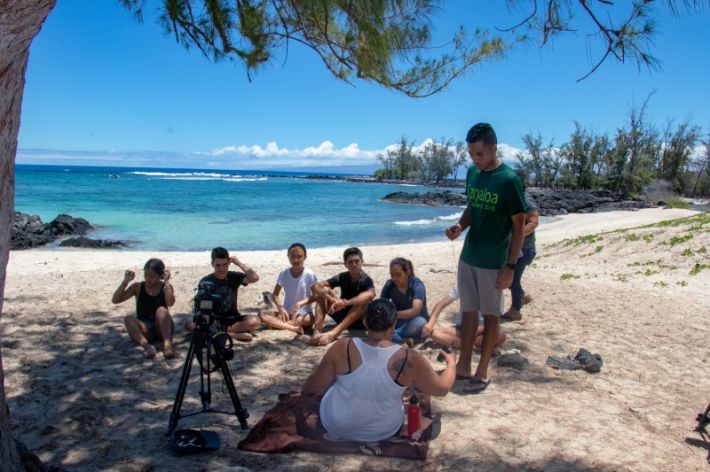As part of an innovative collaboration that will be realized on a global scale, Kamehameha Schools has launched its new educational virtual huaka‘i (learning trip) that highlights the environmental and cultural treasures at Makalawena, a remote wahi pana (special place) that is part of KS’ land holdings in North Kona in West Hawai‘i.
This innovative online educational resource is being showcased at KS’ EdTech Conference this week to showcase exploration and understanding of Hawai‘i’s sacred places to classrooms across the world. Kealakehe Intermediate’s Mathieu Williams, the Hawai‘i State Teacher of the Year, and his students provided feedback on the virtual huaka‘i and presented their work to EdTech attendees in an in-depth look at the value of virtual huaka‘i and how ʻāina-based education can effectively fuse with today’s media and technology.
Haumāna (students) and kumu (teachers) from across West Hawai‘i collaborated on the pilot testing of the project. Along with Kealakehe Intermediate, participating schools also included: Kohala Middle School and kumu Erika Blanco; Ke Kula ‘O ‘Ehunuikaimalino and kumu Alapa‘i Kaulia; and Konawaena Middle School and kumu Kevin Hoag.
“With this project, we bring the mo‘olelo or stories of our kūpuna together with the natural and cultural riches of this unique place to create educational tools for our kumu that are grounded in modern technology and ʻāina-based learning,” said Kaimana Barcarse, KS’ West Hawaiʻi Regional Director. “Virtual huaka‘i enable students across Hawai‘i – and the world – to connect with the ʻāina and explore wahi pana like Makalawena in a way that provides virtual access with minimal impact and in a way they wouldn’t be able to experience otherwise.”
In ‘Ōlelo Hawai‘i or English, students can experience Makalawena virtually and explore in depth the various historical, cultural and environmental features via a variety of methods including interactive 360-degree video, high-resolution photographs and interviews with resource managers.
“There are beautiful, remote places throughout the state rich in stories and lessons that cannot or even should not be easily accessed,” said Williams, who teaches media technology. “Virtual huaka‘i ensure everyone can gain a sense for the significance of these places, for the legacy and history forged here over generations, and perpetuate the lessons of these sites for years to come.”
In April of 2016, an educational partnership was formed between KS and Arizona State University to develop a series of virtual huakaʻi, beginning with Kahaluʻu Ma Kai in West Hawaiʻi.
Virtual huaka‘i enable KS to share the natural and cultural resources it cares for without disturbing the sacred ecosystems and sites, making place-based learning possible everywhere. Visit the virtual huaka’i resource website to access both the Kahalu‘u Ma Kai and Makalawena virtual projects, along with expanded kumu resources to utilize in the classroom.

During the Virtual Huaka‘i experience, Kumu Mathieu Williams and his class met with and learned from Auntie Ku‘ulei Keakealani, a lineal descendant of the area studied at Makalawena.
TAGS
sp2020 goal 2,
sp2020 goal 3
CATEGORIES
Kaipuolono Article, Regions, West Hawai’i, Themes, Culture, Newsroom, Community Education, Department News, Features
Print with photos
Print text only










